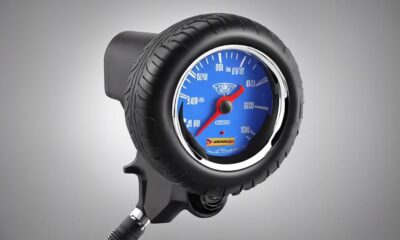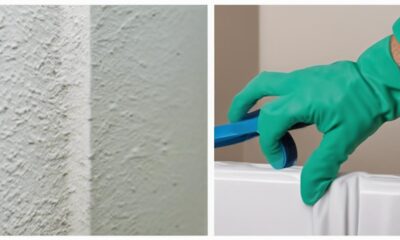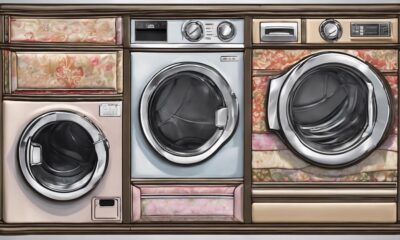Appliances
Why Ceiling Fan Shakes
2025
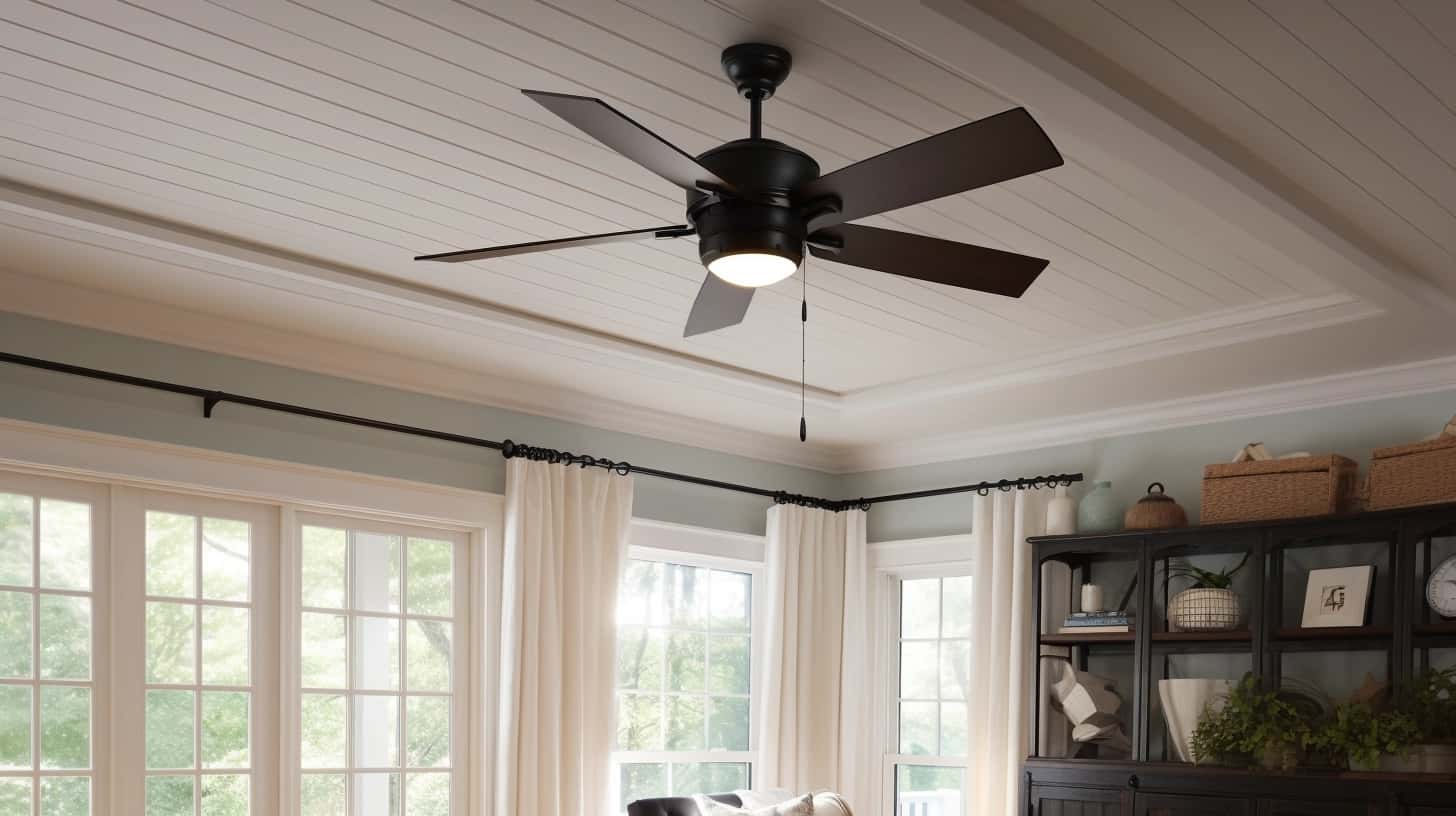
Ever curious about the reason your ceiling fan wobbles? Allow us to illuminate the issue. This is a prevalent problem encountered by numerous individuals, but rest assured, there are explanations for this disconcerting occurrence.
One potential culprit could be loose screws or bolts, causing the fan to wobble. Another possibility is uneven or unbalanced blades, which can create an imbalance in the fan’s rotation. Faulty motor mounts, loose or damaged blade brackets, or improper installation can also contribute to the shaking.
Additionally, excessive fan speed or vibrations from nearby objects can further exacerbate the problem. Even the size and shape of the fan blades can play a role. Lastly, poor quality or cheaply made fans may be more prone to shaking.
Now, let’s delve deeper into each of these factors to better understand why your ceiling fan shakes.
Key Takeaways
- Loose screws or bolts, faulty motor mounts, and loose or damaged blade brackets can cause a ceiling fan to shake.
- Improper installation, dust or debris buildup, and warped or bent blades can also contribute to the shaking of a ceiling fan.
- Inadequate support structure and damaged or worn-out bearings can affect the stability of a ceiling fan.
- Electrical issues such as faulty wiring, loose connections, and power fluctuations can lead to the shaking of a ceiling fan.
Loose Screws or Bolts
Sometimes, ceiling fans shake due to loose screws or bolts. This issue can significantly impact the fan’s performance and lead to unnecessary noise and vibrations. To address this problem, it’s essential to understand the role of blade balancing and motor maintenance.
Blade balancing plays a crucial role in ensuring the smooth operation of a ceiling fan. When a fan’s blades are unbalanced, it can cause the entire unit to shake. This imbalance can occur due to various factors, including loose screws or bolts that hold the blades in place. Therefore, it’s crucial to regularly inspect these fasteners and tighten them if necessary. By ensuring that the screws or bolts are properly secured, you can prevent unnecessary shaking and vibrations.
Additionally, proper motor maintenance is vital for a ceiling fan’s stability. Over time, the motor can accumulate dirt, dust, and debris, which can affect its performance. Regular cleaning and maintenance of the motor will help prevent any buildup that may cause the fan to shake. It’s also essential to lubricate the motor’s moving parts to ensure smooth operation and minimize any potential vibrations.
Uneven or Unbalanced Blades
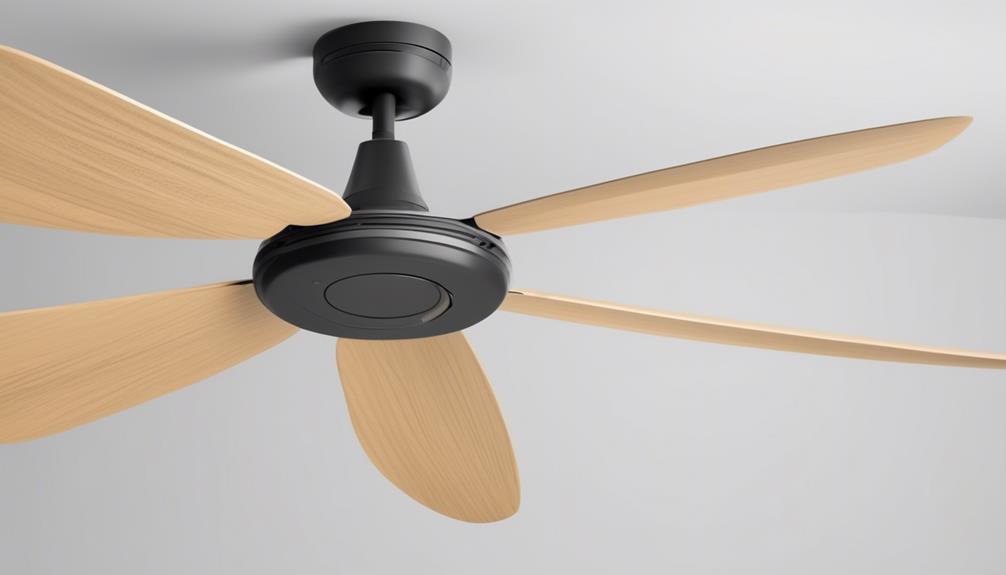
To ensure the smooth operation and stability of a ceiling fan, it is crucial to address the issue of uneven or unbalanced blades. Blade balancing plays a significant role in maintaining the performance and reducing blade wobbling. When the blades are uneven or unbalanced, they can cause the fan to shake, produce an irritating noise, and even reduce its lifespan.
Blade balancing involves adjusting the weight distribution of each blade to ensure that they are evenly weighted. This can be achieved by adding or removing weight from the blades. To determine which blades require adjustment, a simple balance test can be performed. Place a small weight, such as a coin, on top of each blade and observe if any blade causes the fan to wobble more than others.
Once the unbalanced blades are identified, the weight distribution can be adjusted accordingly. This can be done by either adding small weights to the lighter blades or removing weights from the heavier blades. It is important to note that the adjustments should be made in small increments to avoid overcompensating and causing further imbalance.
By addressing the issue of uneven or unbalanced blades through proper blade balancing, the stability and performance of the ceiling fan can be significantly improved. Regular maintenance and periodic blade balancing will ensure a smooth and enjoyable fan experience while prolonging the lifespan of the fan.
Blade Number Weight (grams) 1 10 2 11 3 10 4 11 5 10
Faulty Motor Mounts
Faulty motor mounts can cause the ceiling fan to vibrate excessively and create an annoying noise during operation. This issue occurs when the motor mounts, which are responsible for holding the motor securely in place, become damaged or malfunctioning.
Here are some key points to understand about this problem:
- Damaged Motor: Faulty motor mounts can result in a damaged motor due to the increased vibrations. These vibrations can cause the motor to wear out faster and decrease its overall lifespan.
- Motor Malfunction: Excessive vibrations caused by faulty motor mounts can also lead to motor malfunction. The motor may start to overheat or experience other issues that affect its performance.
- Noise Generation: The vibrations caused by faulty motor mounts can generate an annoying noise, disrupting the peaceful ambiance of your space. This noise can be a result of the motor rubbing against the mount or other components.
- Safety Concerns: A ceiling fan with faulty motor mounts poses a safety risk. The excessive vibrations can loosen other parts of the fan, potentially leading to the detachment of blades or other components.
- Professional Repair: Fixing faulty motor mounts requires professional expertise. It’s crucial to seek the assistance of a qualified technician to diagnose and resolve the issue effectively.
Addressing faulty motor mounts promptly is essential to ensure the smooth and quiet operation of your ceiling fan while maintaining safety standards.
Loose or Damaged Blade Brackets
Loose or damaged blade brackets can result in an unstable ceiling fan, compromising its functionality and potentially causing safety hazards. Blade brackets are essential components that hold the fan blades in place and ensure smooth and balanced rotation. When these brackets become loose or damaged, the fan blades can wobble or shake during operation, leading to an unpleasant noise and a decrease in performance.
To maintain blade balance and prevent issues with blade brackets, regular maintenance is crucial. Inspect the brackets periodically to check for any signs of damage or looseness. If you notice any issues, tighten the screws or bolts that secure the brackets to the fan body. Additionally, ensure that the brackets are aligned correctly, as misalignment can also contribute to instability.
When performing maintenance on blade brackets, it’s important to follow proper safety precautions. Turn off the fan and disconnect the power supply before starting any work. Use appropriate tools and techniques to tighten the brackets securely without causing any damage.
Improper Installation
Improper installation can lead to a variety of issues with a ceiling fan, affecting its stability and overall performance. When it comes to installing a ceiling fan, attention to detail is crucial to ensure its proper functioning. Here are some common problems that can arise from improper installation:
- Electrical issues: Faulty wiring or incorrect connections can result in electrical problems. This can lead to short circuits, power surges, or even electrical fires. It’s important to follow the manufacturer’s instructions and consult a professional electrician if needed.
- Unbalanced fan: An improperly installed ceiling fan may not be balanced correctly, causing it to shake or wobble during operation. This can be not only annoying but also potentially dangerous. Properly securing the fan to the ceiling and ensuring that all components are properly aligned can prevent this issue.
- Inadequate support: Ceiling fans are heavy and require proper support to prevent accidents. Improper installation can result in weak mounting or insufficient support, leading to the fan becoming loose or falling from the ceiling.
- Incorrect blade angle: The angle of the fan blades plays a significant role in its performance. Incorrect blade angle can affect the airflow, reducing the fan’s efficiency and causing unnecessary noise.
- Incorrect switch installation: Installing the fan on the wrong type of switch or not properly connecting the switch can result in the fan not functioning correctly or not working at all.
Proper installation is essential for the safe and efficient operation of a ceiling fan. It’s recommended to consult a professional installer or electrician to ensure that the fan is installed correctly, avoiding potential electrical issues and maintaining optimal performance.
Dust or Debris Buildup
Dust or debris buildup can negatively impact the performance and efficiency of a ceiling fan. When dust and debris accumulate on the blades of a ceiling fan, it can disrupt the balance of the fan, leading to vibrations and shaking. This imbalance not only affects the smooth operation of the fan but also puts unnecessary strain on the motor, reducing its lifespan.
To prevent dust and debris buildup, regular cleaning techniques should be employed. Start by turning off the fan and allowing it to come to a complete stop. Then, using a soft cloth or a duster, gently wipe the blades to remove any loose dust. For more stubborn dirt or grime, a mild detergent diluted in water can be used. Be sure to dry the blades thoroughly after cleaning to prevent moisture damage.
It is important to pay special attention to the balance of the fan blades. If the blades aren’t properly balanced, they can cause the fan to shake. To check the blade balance, use a blade balancing kit or simply observe the fan while it’s running. If any blades appear to be drooping or wobbling, they may need to be adjusted or replaced.
Warped or Bent Blades
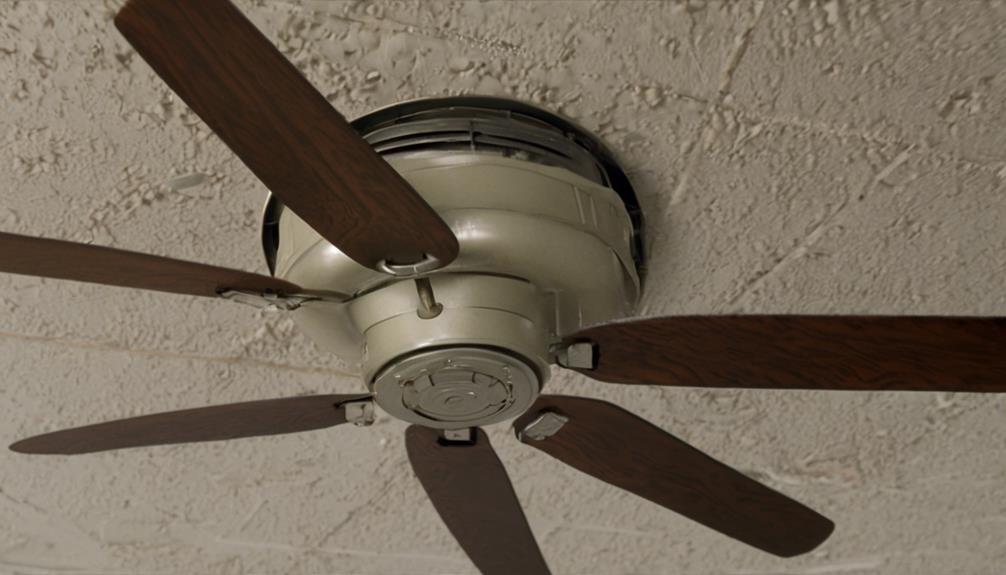
When it comes to ceiling fans, warped or bent blades can cause a myriad of issues.
Blade warping can occur due to heat, moisture, or improper installation, leading to an imbalance that causes the fan to shake.
Bent blades, on the other hand, can disrupt the airflow and create noise.
Both of these problems can result in an uncomfortable and inefficient fan operation.
Blade Warping Causes
Create an image capturing the aftermath of a ceiling fan accident: a set of warped blades frozen mid-spin, their misshapen forms casting distorted shadows on the room, revealing the disastrous consequences of blade warping.
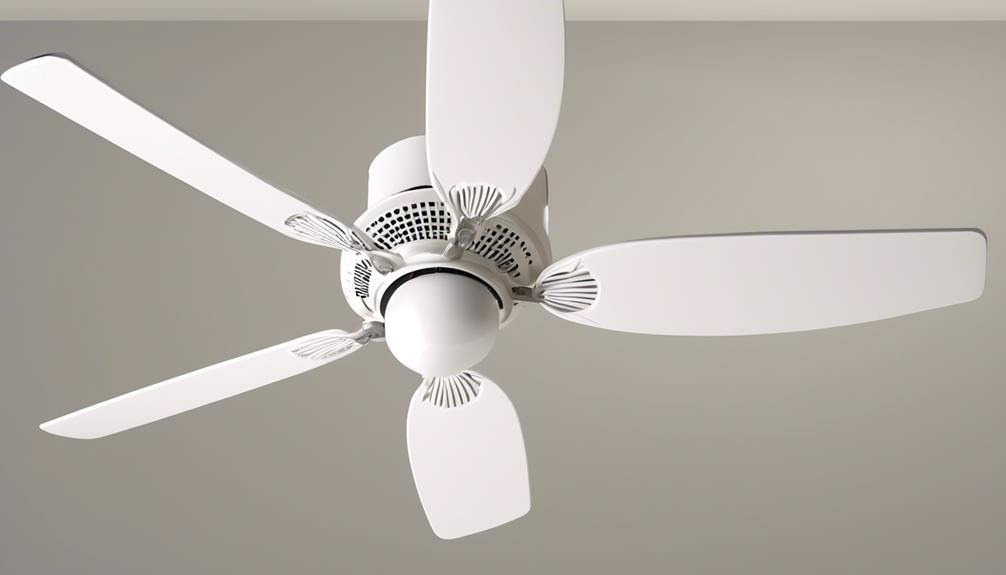
Blade warping causes ceiling fans to shake and requires immediate attention to prevent further damage. When the blades of a ceiling fan become warped or bent, it disrupts the balance and symmetry of the fan, resulting in vibrations that can be felt throughout the room.
There are several causes of blade warping, including:
- Incorrect blade alignment issues
- Excessive heat exposure
- Moisture or water damage
- Impact or physical damage
- Poor quality materials or manufacturing
To address blade warping, it’s essential to identify the root cause and take appropriate measures. Some possible solutions include adjusting the blade alignment, replacing the warped blades, or installing vibration dampening solutions.
Bent Blade Problems
Create an image showcasing a ceiling fan with a close-up view of its warped or bent blades. Capture the blades’ distorted shape and emphasize the irregularity, conveying the problem of why ceiling fans shake.
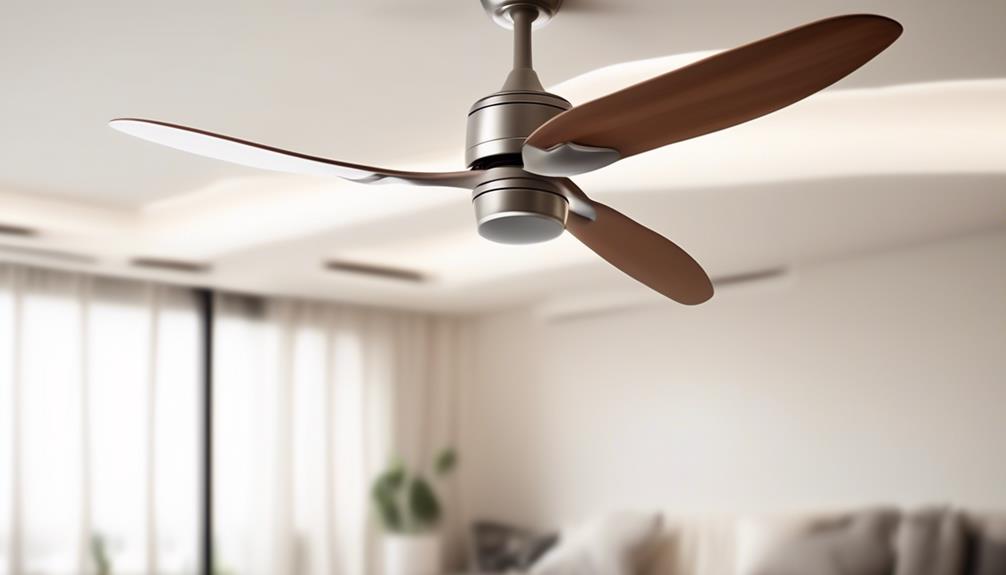
To address the issue of blade warping, it is crucial to address the related problem of bent blades, which can significantly impact the functionality and stability of a ceiling fan. Bent blades can occur due to a variety of reasons, such as accidental mishandling, poor installation, or excessive force applied to the blades. When blades are bent, they become unbalanced, leading to an uneven distribution of weight. This imbalance can cause the ceiling fan to shake and wobble, resulting in an uncomfortable and potentially hazardous environment. To rectify this issue, blade balancing and blade alignment are essential. Blade balancing involves ensuring that each blade has an equal weight distribution, while blade alignment ensures that all blades are properly aligned to maintain smooth operation. By addressing these bent blade problems, the functionality and stability of the ceiling fan can be restored, providing a more comfortable and safe experience for the users.
Problem Causes Solution Bent Blades Mishandling, Poor Installation, Excessive Force Blade Balancing, Blade Alignment
Blade Misalignment Effects
Create an image capturing the close-up view of a ceiling fan blade, visibly warped and bent, with minute cracks along its surface. The misalignment is evident as the blade moves, causing the entire fan to shake.
Blade misalignment can have detrimental effects on the performance and stability of a ceiling fan, particularly when the blades become warped or bent. When blade alignment is compromised, it can lead to several issues that affect the overall functionality of the fan. These include:
- Reduced airflow efficiency: Misaligned blades disrupt the smooth flow of air, leading to decreased airflow and less effective cooling.
- Increased noise and vibration: Imbalanced blades can cause the fan to shake and produce unwanted noise, making it less enjoyable to use.
- Premature wear and tear: The stress caused by blade misalignment can result in accelerated wear and tear on the motor, reducing the fan’s lifespan.
- Uneven air distribution: Warped or bent blades can cause uneven air distribution, creating hot and cold spots in the room.
- Safety hazards: Severely misaligned blades can pose a safety risk, potentially causing the fan to detach from the ceiling or blades to break off.
To ensure optimal performance, it’s crucial to maintain proper blade balance and alignment. Regularly inspecting and correcting any misalignment issues won’t only enhance the fan’s efficiency but also extend its lifespan.
Inadequate Support Structure
The shaking of a ceiling fan can often be attributed to an inadequate support structure. When it comes to ceiling fan installation, faulty installation and inadequate fan support are common culprits that can lead to a wobbly and unstable fan.
Faulty installation occurs when the fan isn’t securely attached to the ceiling. This can happen if the mounting bracket isn’t properly aligned or if the screws used to secure the fan are loose.
Inadequate fan support, on the other hand, refers to a support structure that isn’t strong enough to handle the weight and movement of the fan. This can occur if the ceiling joists aren’t properly reinforced or if the fan is installed on a surface that isn’t sturdy enough.
To ensure a stable and properly functioning ceiling fan, it’s crucial to address these issues. Proper installation includes ensuring that the mounting bracket is securely attached to the ceiling and that the fan is properly aligned and balanced. Additionally, it’s important to ensure that the support structure, such as the ceiling joists, are strong enough to handle the weight and movement of the fan.
Damaged or Worn-Out Bearings
Damaged or worn-out bearings can lead to shaking in a ceiling fan. When the bearings are damaged, they may not rotate smoothly, causing the fan to vibrate.
Similarly, worn-out bearings may cause the fan to shake due to increased friction and instability.
Bearing Damage Causes Shaking
Create an image showcasing the internal mechanism of a ceiling fan, focusing on the damaged or worn-out bearings. Illustrate the shaking caused by the imbalance, using detailed visuals of loose and misaligned parts.
When bearings in a ceiling fan become damaged or worn-out, shaking may occur. Bearing damage is a common issue that can lead to the malfunctioning of the fan. It’s important to perform regular bearing maintenance to avoid such problems. Signs of bearing damage include excessive noise, vibration, and wobbling of the fan.
To address this issue, here are some key points to consider:
- Inspect the bearings: Check for any visible signs of wear or damage.
- Listen for unusual sounds: Pay attention to any squeaking or grinding noises coming from the fan.
- Check for excessive movement: If the fan wobbles or shakes excessively, it may indicate bearing damage.
- Replace worn-out bearings: If the bearings are damaged, it’s crucial to replace them promptly.
- Seek professional help if needed: If you’re unsure about bearing maintenance or need assistance, consult a professional technician.
Regular maintenance and timely repairs can ensure the smooth operation of your ceiling fan and prevent unnecessary shaking caused by bearing damage.
Worn-Out Bearings Shake
Create an image capturing the intricate mechanism of a ceiling fan, its bearings worn-out and damaged. Depict the fan blades in motion, subtly shaking, as the distressed bearings struggle to maintain stability.
Worn-out bearings in a ceiling fan can cause shaking and should be promptly replaced to ensure smooth operation. Bearings are crucial components that allow the fan to rotate smoothly. Over time, these bearings can become worn-out due to constant friction and lack of proper maintenance.
When the bearings wear out, the fan may start to shake, leading to an unpleasant noise and an unbalanced rotation. To prevent this, regular blade maintenance is essential. Cleaning the blades and ensuring they’re properly balanced can help reduce stress on the bearings. Additionally, noise reduction can be achieved by applying lubrication to the bearings.
If shaking persists even after these measures, it’s recommended to seek professional assistance to replace the worn-out bearings and restore the fan’s smooth operation.
Misaligned Fan Blades
To ensure smooth and efficient operation, it’s important to address the issue of misaligned fan blades. When the fan blades aren’t properly aligned, it can lead to fan wobbling, which can be both annoying and potentially dangerous. Here are some key points to consider:
- Blade alignment: Misaligned fan blades can cause the fan to vibrate and shake. This can’t only create an unpleasant noise but also result in reduced performance and increased wear and tear on the motor.
- Causes of misalignment: There are several factors that can contribute to misaligned fan blades. These include improper installation, loose screws, or even natural wear and tear over time.
- Checking for misalignment: To determine if your fan blades are misaligned, you can visually inspect them while the fan is turned off. Look for any noticeable gaps or unevenness between the blades.
- Fixing misalignment: If you notice that your fan blades are misaligned, it’s important to take immediate action. Start by tightening any loose screws and ensuring that all the blades are securely attached to the fan motor.
- Seeking professional help: If the misalignment persists or if you’re unsure about how to properly align the fan blades, it’s recommended to seek the assistance of a professional technician who can diagnose and fix the issue correctly.
Electrical Issues
We need to address the potential electrical issues that could be causing the fan to shake. Faulty wiring, loose connections, and power fluctuations are common culprits.
Faulty wiring can cause the fan to receive inconsistent power, leading to vibrations.
Loose connections can create an unstable electrical connection, causing the fan to shake.
Power fluctuations, such as voltage spikes or drops, can also impact the smooth operation of the fan.
Faulty Wiring
Create an image showcasing a ceiling fan in motion, with visible sparks emitting from loose wires. The fan’s unstable rotation, caused by faulty electrical wiring, is emphasized by blurred blades and a dimly lit room.
Faulty wiring in the ceiling fan can cause it to shake, posing a potential safety hazard. When it comes to electrical issues, it’s crucial to address them promptly to ensure the smooth functioning of your ceiling fan.
Here are some common reasons why faulty wiring can lead to a shaking ceiling fan:
- Loose screws or bolts: Loose connections between the fan blades and the motor can cause the fan to wobble. This can be caused by poorly tightened screws or bolts.
- Improper grounding: If the fan isn’t properly grounded, it can result in electrical issues that may cause the fan to shake.
- Overloaded circuits: If the ceiling fan is connected to an overloaded circuit, it can lead to electrical problems that can cause the fan to shake.
- Faulty wiring connections: Faulty wiring connections can disrupt the flow of electricity, leading to the fan shaking.
- Inadequate insulation: Insufficient insulation around the electrical wires can result in electrical problems, including fan shaking.
Regular maintenance and inspection of the wiring can help identify and resolve any faulty wiring issues, ensuring the safe and smooth operation of your ceiling fan.
Loose Connections
Create an image showcasing a close-up view of a ceiling fan with visible loose electrical connections, depicting exposed wires, disengaged connectors, and sparks, highlighting the potential hazards and causes of ceiling fan shaking.
Loose connections in the electrical wiring of a ceiling fan can lead to shaking and pose a safety risk. When the electrical connections aren’t securely fastened, it can result in intermittent power supply to the fan motor. This inconsistent flow of electricity causes the fan blades to rotate unevenly, leading to wobbling and shaking.
Loose connections can occur due to improper installation or over time as the fan is used. It’s essential to ensure that all electrical connections are properly tightened and secured to prevent any potential hazards. Regular maintenance and inspection of the ceiling fan’s electrical connections are crucial to identify and rectify any loose connections promptly.
Power Fluctuations
Create an image showcasing a ceiling fan in motion, its blades blurred, hanging from a visibly shaky ceiling. Show electrical wires in disarray, with sparks and dimming lights in the background, representing power fluctuations and electrical issues.
Power fluctuations in the electrical system can cause the ceiling fan to shake and disrupt its smooth operation. These power surges and voltage fluctuations can occur due to various reasons and can have a significant impact on the performance of the fan. Here are some key points to consider:
- Power surges: Sudden increases in voltage can result from lightning strikes, faulty wiring, or issues with the power grid. These surges can cause the fan to jerk or shake.
- Voltage fluctuations: Fluctuations in voltage levels can occur when multiple appliances are being used simultaneously, or due to problems with the electrical supply. These fluctuations can affect the fan’s speed and stability.
- Electrical system issues: Loose connections, faulty wiring, or inadequate grounding can also contribute to power fluctuations and impact the fan’s operation.
- Protection devices: Installing surge protectors or voltage stabilizers can help safeguard the fan from power surges and voltage fluctuations.
- Professional assistance: If power fluctuations persist, it’s advisable to consult a qualified electrician to identify and resolve any underlying electrical issues.
Understanding the impact of power surges and voltage fluctuations is crucial in maintaining the smooth operation of your ceiling fan. By addressing these issues, you can ensure a stable and comfortable environment.
Excessive Fan Speed
Is the excessive speed of your ceiling fan causing it to shake?
Excessive fan speed can lead to a variety of issues, including excessive noise and motor overheating. When a ceiling fan operates at high speeds, it can create vibrations that cause the fan to shake. These vibrations can be caused by a number of factors, such as unbalanced blades, loose screws or brackets, or a worn-out motor.
One common reason for excessive fan speed is incorrect settings on the fan’s control switch. Make sure that the switch is set to the appropriate speed for your fan. If the fan is still shaking at the correct speed, it may be necessary to adjust the blade pitch. The pitch of the blades determines the amount of air that the fan moves, and a proper pitch can help reduce vibrations.
Another potential cause of excessive fan speed is a faulty motor. Over time, the motor can wear out or become damaged, leading to irregular fan speeds and vibrations. In such cases, it may be necessary to replace the motor to restore proper operation.
Vibration From Nearby Objects
Vibration from nearby objects can contribute to the shaking of a ceiling fan. When a fan is mounted close to other objects, such as walls or furniture, the vibration from those objects can transfer to the fan, causing it to shake. This can be particularly problematic if the fan isn’t properly isolated or if it’s made of materials that aren’t able to withstand the vibrations.
To help you understand the impact of vibration from nearby objects on a ceiling fan, consider the following:
- Vibration isolation: Properly isolating the fan from nearby objects can minimize the transfer of vibrations. This can be achieved through the use of rubber pads or other vibration-absorbing materials between the fan and its mounting surface.
- Fan blade material: The material of the fan blades can also affect the level of vibration. Blades made of lightweight materials, such as plastic, may be more prone to vibrating. Opting for fan blades made of sturdier materials, such as metal or wood, can help reduce vibrations.
- Distance from nearby objects: Increasing the distance between the fan and nearby objects can also help reduce vibration. By ensuring that there’s ample space between the fan and walls, furniture, or other objects, you can minimize the potential for vibration transfer.
- Mounting technique: The way the fan is mounted can also impact its susceptibility to vibrations. Using sturdy mounting brackets and ensuring that the fan is securely attached to the ceiling can help minimize vibrations.
- Regular maintenance: Regularly inspecting and maintaining your ceiling fan can help identify and address any potential issues that may contribute to vibrations. Checking for loose screws, ensuring proper alignment, and lubricating moving parts can all help reduce vibrations.
Fan Blade Size and Shape
One factor that can significantly affect the performance of a ceiling fan and contribute to its shaking is the size and shape of the fan blades. The fan blade material and aerodynamic design play crucial roles in determining the stability and efficiency of the fan.
The material used for the fan blades can impact their performance. Typically, fan blades are made of materials such as wood, metal, or plastic. Each material has its own characteristics that influence the fan’s operation. For example, wooden blades tend to be heavier, which can reduce vibrations but may also require a stronger motor. On the other hand, metal blades are lighter and can provide better airflow, but they may be more prone to vibrations if not properly balanced. Plastic blades are lightweight and can be more aerodynamically designed, reducing the chances of shaking.
The shape of the fan blades is another important aspect to consider. Fan blades with a more aerodynamic design are generally more efficient and produce less noise. They’re specifically engineered to move air smoothly and quietly, reducing the likelihood of shaking. Blades with a curved or angled shape can create a more focused airflow and minimize turbulence, resulting in a more stable fan.
Poor Quality or Cheaply Made Fans
Poor quality or cheaply made fans can contribute to the shaking and instability of a ceiling fan. When it comes to ceiling fans, ensuring the highest quality is essential for optimal performance and longevity. Here are some factors to consider when it comes to the quality of ceiling fans:
- Blade Material Quality: The materials used to construct the fan blades play a significant role in its stability. Fans made with low-quality materials are more prone to vibrations and wobbling, leading to an unsteady fan.
- Motor Power Adequacy: The motor is the heart of the ceiling fan, and its power directly impacts its stability. Inadequate motor power can cause the fan to struggle, resulting in shaking and wobbling.
- Manufacturing Standards: Cheaply made fans often lack proper manufacturing standards, compromising their stability. When choosing a ceiling fan, it’s crucial to opt for brands that adhere to strict quality control measures.
- Component Durability: The durability of various components, such as the motor housing and mounting hardware, affects the overall stability of the fan. Poorly constructed components can lead to vibrations and shaking.
- Balancing Mechanism: High-quality fans usually incorporate advanced balancing mechanisms to ensure smooth operation. Cheaper fans may lack such mechanisms, leading to increased vibrations and instability.
Investing in a ceiling fan with superior blade material quality, adequate motor power, and excellent manufacturing standards is essential for a stable and reliable fan. By choosing a well-made fan, you can enjoy a quiet and wobble-free cooling experience.
Frequently Asked Questions
How Can I Fix a Ceiling Fan That Is Shaking Due to Excessive Fan Speed?
To fix a shaking ceiling fan caused by excessive speed, we can perform fan motor maintenance and balance the fan blades.
By cleaning and lubricating the motor, we ensure smooth operation and reduce vibrations.
Balancing the blades involves attaching weights to counteract any unevenness. This precision work guarantees a stable and efficient fan.
Can Nearby Objects Cause Vibrations in a Ceiling Fan?
Yes, nearby objects can indeed cause vibrations in a ceiling fan. During ceiling fan installation, it’s important to ensure that there’s enough clearance between the fan blades and any surrounding objects.
Common causes of ceiling fan vibrations include improper installation, unbalanced blades, or loose screws. These vibrations can lead to the fan shaking, which can be both annoying and potentially dangerous.
Therefore, it’s crucial to address any issues promptly to ensure a smooth and stable operation of the ceiling fan.
Does the Size and Shape of the Fan Blades Affect Its Stability?
Fan blade design plays a crucial role in the stability of a ceiling fan. The size and shape of the blades can affect how the fan operates. Different blade designs can create different airflow patterns, which can impact the stability of the fan.
Additionally, the material used for the blades can also affect stability. Some materials may be more prone to vibrations, leading to a shaky fan.
Therefore, it’s important to consider both the size and shape of the fan blades, as well as the material used, when aiming for a stable ceiling fan.
Are There Any Electrical Issues That Can Cause a Ceiling Fan to Shake?
There can be several electrical issues that can cause a ceiling fan to shake. Faulty electrical wiring can lead to inconsistent power supply, causing the fan to wobble.
Additionally, a motor malfunction can also result in an unsteady fan. It’s important to have a professional inspect the electrical connections and motor of your ceiling fan to ensure proper functioning and stability.
As the saying goes, ‘A stitch in time saves nine,’ addressing electrical issues promptly can prevent further damage and ensure the longevity of your ceiling fan.
Are Poor Quality or Cheaply Made Fans More Prone to Shaking?
Poor quality fans are more prone to shaking due to several factors. One of the main reasons is the lack of proper fan blade balance. When the blades aren’t evenly weighted, it can cause vibrations that result in the fan shaking.
Additionally, cheaply made fans may have inferior motor components that contribute to instability. Investing in a high-quality fan with balanced blades and a sturdy motor will greatly reduce the likelihood of shaking.
Conclusion
In conclusion, it’s vital to address the factors that contribute to a shaking ceiling fan.
With loose screws or bolts, uneven blades, faulty motor mounts, or damaged blade brackets, the fan’s stability can be compromised.
Additionally, improper installation, excessive fan speed, vibration from nearby objects, or poor quality fans can all contribute to the shaking phenomenon.
Considering that a single unbalanced blade can create up to 50 pounds of force, the image of a turbulent and unstable fan is brought to mind.
- About the Author
- Latest Posts
Introducing Charles, the Editor in Chief at ByRetreat, whose passion for interior design and editorial excellence elevates every remote workspace to new heights. With his keen eye for detail, impeccable taste, and expertise in design, Charles brings a wealth of knowledge and creativity to the ByRetreat team.
As the Editor in Chief of a renowned lifestyle blog, Charles has honed his skills in curating captivating content and staying up-to-date with the latest trends in interior design. His deep understanding of aesthetics and the power of storytelling through design enables him to create remote workspaces that are not only visually stunning but also rich in personality and meaning.
Garage Door Opener
DIY: Install Garage Door Opener Keypad in 10 Steps
Journey into seamless garage access with our 10-step guide to installing a keypad – unlocking convenience at your fingertips.

When it comes to improving the functionality of your garage door system, adding a keypad can offer a convenient way to enter your garage.
However, the process of installing one might seem daunting at first glance. But fear not, as we have broken down the steps into a clear and concise guide that will have you confidently tackling this project in no time.
Stay tuned for essential tips and tricks that will ensure a smooth installation process and have you enjoying the convenience of your newly installed keypad in no time.
Key Takeaways
- Plan and prepare tools and location for keypad installation with attention to accessibility and visibility.
- Protect the keypad from weather elements with proper positioning and a weatherproof cover.
- Program the keypad securely, ensuring alignment and stability for optimal performance.
- Verify wiring connections, test the keypad's functionality, and finalize installation with thorough checks for proper operation.
Gather Required Tools and Materials
To begin the installation process smoothly, ensure we've all the necessary tools and materials at hand, such as a screwdriver, screws, and the keypad itself. When gathering these items, make sure they're compatible with your specific garage door opener model. It's crucial to have everything organized and easily accessible outside the garage where the installation will take place. Check the contents of the keypad box to confirm all components are included, avoiding any setbacks during the setup. Having a stable surface to lay out the tools and materials will facilitate quick access and prevent any potential mishaps.
Proper preparation is key to a successful installation. By ensuring we've the correct tools and materials ready beforehand, we can make the process more efficient and eliminate unnecessary delays. By double-checking and gathering all necessary items outside the garage, we set the stage for a smooth and hassle-free installation of the garage door opener keypad.
Locate the Ideal Placement

When choosing the ideal placement for your garage door opener keypad, we need to consider a few key points.
Ensure the keypad is strategically positioned for easy access by all users, at a comfortable height.
Additionally, think about weather protection to prolong the keypad's lifespan.
Choose Strategic Position
For optimum accessibility and ease of use, position the keypad at a height that caters to both adults and children while ensuring comfortable operation.
When choosing the strategic position for the garage door opener keypad, consider installing it at a level that's easily reachable for all users. Ensure the keypad isn't too high or too low, allowing for convenient operation without straining or bending.
Take note of any potential obstructions or interferences in the selected mounting location to avoid issues with functionality. Additionally, aim to place the keypad in a well-lit area that provides clear visibility for entering the pin code, enhancing user experience and security.
Consider these factors to determine the ideal placement for the keypad to optimize its functionality within your garage.
Ensure Easy Access
Positioning the garage door opener keypad at a height accessible to all users, typically around 5 feet from the ground, ensures convenient and easy access for efficient operation.
Placing the keypad in a well-lit area enhances visibility, especially during nighttime use. Be mindful of obstructions or sharp edges that could obstruct the keypad's functionality and accessibility.
Opt for a location shielded from extreme weather conditions to prolong the keypad's lifespan. Validate the keypad's placement by testing it from various entry angles to guarantee effortless access.
Consider Weather Protection
After ensuring easy access for efficient operation, the next crucial step is to consider weather protection when locating the ideal placement for your garage door opener keypad. To shield the keypad from direct exposure to rain, snow, or extreme weather conditions, it is advisable to install it in a sheltered area. Look for spots under an eave or a covered porch to extend the keypad's lifespan. If mounting the keypad in an exposed area, consider weatherproofing it with a protective cover or housing. Choosing a location that minimizes contact with water and moisture is key to prevent damage and maintain functionality over time. Ensuring weather protection for the keypad is essential for outdoor installations to uphold performance and longevity.
| Placement | Protection |
|---|---|
| Under an eave | Shield from rain and snow |
| Covered porch | Protection from extreme weather |
| Weatherproof cover | Prevent direct exposure to moisture |
Prepare the Keypad Mounting Surface

To ensure a secure and professional installation, start by cleaning the mounting surface with a damp cloth to remove any dirt or debris that may affect the keypad's adherence.
Once the surface is clean, use a level to ensure it's flat before proceeding with the installation. This step is crucial in achieving a polished and secure finish for your keypad.
Additionally, consider using a stud finder to locate and mark the studs on the wall. This will provide added support when mounting the keypad, ensuring it stays securely in place.
It's important to avoid mounting the keypad near any moving parts of the garage door to prevent interference or damage during operation.
Lastly, double-check the mounting surface for stability and suitability before proceeding with the installation to avoid any potential issues down the line.
Following these steps will help you set up your keypad efficiently and effectively.
Install Batteries in the Keypad

Let's start by checking the keypad manual for the specific 9-volt battery needed and opening the battery compartment accordingly.
Make sure to insert the battery following the polarity markings inside the compartment and securely close it for proper functionality.
Testing the keypad afterward will confirm the correct installation of the battery and ensure the keypad is ready for use.
Battery Installation Process
For optimal keypad performance, ensure the correct batteries are installed according to the manufacturer's specifications. Here's how to install the batteries properly:
- Check the Keypad Manual: Look up the specific battery requirements, typically 9-volt or AAA batteries, in the manual.
- Open the Battery Compartment: Use a screwdriver or follow the keypad's sliding mechanism to access the battery compartment.
- Insert Batteries Correctly: Pay attention to the polarity markings inside the compartment and insert the batteries accordingly.
- Securely Close the Compartment: Ensure the battery compartment is closed securely to establish proper connection and functionality.
Remember to replace the batteries periodically to maintain peak performance for your keypad.
Powering Up the Keypad
After successfully installing the batteries in the keypad, the next step is to power up the device by closing the cover securely to ensure proper functionality. To emphasize the importance of battery maintenance and replacement, here is a table outlining key points:
| Battery Maintenance Tips | |
|---|---|
| 1. Check battery life regularly | 2. Ensure proper polarity alignment |
| 3. Replace batteries promptly when low | 4. Avoid mixing old and new batteries |
| 5. Keep the battery compartment clean and dry | |
Following these guidelines will help maintain the keypad's efficiency and prevent operational issues. Remember, a well-powered keypad is essential for seamless garage door opener functionality.
Program the Keypad With Your Opener

To program the keypad with your opener, locate the colored learn button near the motor unit of the garage door opener. Different colors of learn buttons indicate specific programming methods for the keypad. Follow the manufacturer's instructions, as they typically involve a sequence of button presses to initiate programming mode.
Here are the steps to program the keypad accurately:
- Identify the color of the learn button on your garage door opener.
- Enter the programming mode by pressing the designated buttons on the keypad.
- Input a four-digit pin that you'll use to operate the keypad.
- Press the learn button on the garage door opener to synchronize the keypad with the opener.
It is crucial to test the programmed keypad by entering the pin and operating the garage door. This ensures successful synchronization and allows you to verify that the keypad is working correctly with your garage door opener.
Secure the Keypad in Place

Let's ensure the keypad is securely fastened in place by carefully aligning it with the level before tightening the screws evenly. Ensuring the keypad is straight is crucial to prevent any future issues, such as misalignment or difficulties in using the keypad. Here is a handy table to guide you through securing the keypad:
| Step | Action |
|---|---|
| 1 | Use a level to check alignment. |
| 2 | Tighten screws evenly for stability. |
| 3 | Confirm snug fit against the wall. |
Connect the Wiring to the Opener

Let's now tackle the crucial step of connecting the wiring to the opener.
We'll provide an overview of the wiring connections, ensure proper wire termination, and test the connection for functionality.
This process is vital to ensure your keypad communicates effectively with the garage door opener.
Wiring Connections Overview
Before proceeding with the wiring connections for the keypad installation, ensure that the power to the garage door opener is turned off.
Here's an overview of the wiring connections process:
- Identify the terminals on the garage door opener where the keypad wiring will be connected.
- Match the keypad wires to the corresponding terminals on the opener based on the installation instructions.
- Use wire nuts to securely connect the keypad wires to the opener terminals for a reliable connection.
- Double-check the wiring connections to ensure they're properly seated and insulated before restoring power to the opener.
Proper Wire Termination
Have the wire strippers handy to carefully remove the insulation from the ends of the keypad wires before matching them to the corresponding terminals on the garage door opener.
Ensure to match the colors of the keypad wires to the designated terminals on the opener.
Insert each wire into its assigned terminal and securely tighten the screws to establish a reliable connection.
It's crucial to double-check all connections to confirm there are no loose wires or exposed copper, which could lead to electrical hazards.
Adhering to the manufacturer's guidelines for wire termination is essential to prevent any operational issues.
Following these steps diligently will help guarantee a safe and efficient installation of your garage door opener keypad.
Testing the Connection
After securely connecting the keypad wiring to the designated terminals on the garage door opener, the next crucial step is to test the connection to ensure proper functionality before finalizing the installation. Here are four essential steps to follow:
- Activate the Keypad: Press a few random numbers on the keypad to check if the display lights up and responds.
- Test with the Opener: Enter the access code followed by the open/close button to see if the garage door responds accordingly.
- Check for Consistency: Repeat the process multiple times to confirm consistent operation.
- Inspect for Errors: Look for any error codes or unusual behavior during testing to address any potential issues promptly.
Test the Keypad Functionality

To ensure the smooth operation of the keypad, thoroughly test its functionality by pressing all buttons to confirm responsiveness and entering the programmed PIN for seamless garage door control. When testing the keypad, ensure that each button responds promptly and accurately to your touch. Next, input the programmed PIN to verify that the garage door opens and closes as intended. Additionally, check if the keypad illuminates correctly for easy use in different lighting conditions. Look out for any error messages or beeping sounds that could signal problems with programming or connectivity. Evaluate the keypad's range by testing its operation from various distances to guarantee reliable performance.
| Keypad Functionality Test | ||
|---|---|---|
| Button Responsiveness | Programmed PIN Entry | Illumination Check |
| Error Message Detection | Range Evaluation |
Adjust Keypad Settings as Needed

Let's seamlessly continue our installation process by adjusting the keypad settings as needed for added security and convenience. Here are some essential adjustments you may want to consider:
- Change Pin Code: Enhance security by customizing the four-digit pin code on the keypad regularly.
- Customize Features: Take control of additional garage door opener features, such as lights, by customizing the keypad settings to suit your preferences.
- Time Delay Feature: Prevent accidental activation of the garage door opener by setting up a time delay feature on the keypad.
- Vacation Mode: Enable vacation mode on the keypad to disable remote access when you're away for an extended period, enhancing the security of your garage.
Remember to refer to the manufacturer's instructions for adjusting advanced settings on the keypad to ensure optimal performance.
Enjoy Your Newly Installed Keypad

Upon completing the installation of your new keypad, take a moment to familiarize ourselves with its functions and button layout for seamless operation. Understanding how each button corresponds to specific actions will enhance your experience with the keypad.
Test its functionality multiple times to ensure it consistently works as expected. Consider setting up temporary access codes for guests or service providers to make entry more convenient.
It's essential to keep the keypad clean and free from debris to maintain its functionality over time. Remember to note down the keypad's location and pin code for future reference or troubleshooting purposes.
Frequently Asked Questions
Can I Add a Keypad to Existing Garage Door Opener?
Yes, we can add a keypad to an existing garage door opener. It's a straightforward process that enhances security and provides keyless entry.
Keypads work with various garage door opener brands and models. This upgrade is cost-effective and seamlessly integrates into your current setup with proper installation and programming.
Enjoy the convenience and peace of mind that a keypad brings to your garage door system.
Which Is Better Wired or Wireless Garage Door Keypad?
When it comes to choosing between a wired or wireless garage door keypad, it's essential to weigh the pros and cons.
Wired keypads offer reliability without battery reliance, but may need professional installation due to wiring requirements.
On the other hand, wireless keypads provide flexibility and are easier to install DIY.
Understanding your preferences and garage door opener setup will help determine which option suits you best.
Can You Hardwire a Garage Door Keypad?
Yes, we can hardwire a garage door keypad. It involves connecting the keypad directly to the power source of the garage door opener for a reliable power supply. Check the keypad's instructions to confirm hardwiring compatibility and follow the correct steps.
This method offers a more stable power source than batteries, but it may not be essential for all setups. Hardwiring is an option for those seeking a consistent power solution.
Can You Install a Garage Door Opener by Yourself?
Yes, we can install a garage door opener by ourselves. It's a manageable task with the right tools and instructions. Doing it independently can save us money and give us a sense of accomplishment.
Before starting, ensure the opener is compatible with our system. Following step-by-step guides is key to success. With attention to detail and patience, most of us can tackle this project successfully and enjoy the convenience of a keypad entry system.
Conclusion
In conclusion, with our 10-step guide, installing a garage door opener keypad can be a straightforward DIY project that adds convenience to your daily routine.
Remember, 'measure twice, cut once' to ensure accuracy and precision during the installation process.
By following our detailed instructions and taking your time to do it right, you can enjoy the benefits of easy access to your garage with just a few simple clicks.
Happy keypad installing!
- About the Author
- Latest Posts
Introducing Ron, the home decor aficionado at ByRetreat, whose passion for creating beautiful and inviting spaces is at the heart of his work. With his deep knowledge of home decor and his innate sense of style, Ron brings a wealth of expertise and a keen eye for detail to the ByRetreat team.
Ron’s love for home decor goes beyond aesthetics; he understands that our surroundings play a significant role in our overall well-being and productivity. With this in mind, Ron is dedicated to transforming remote workspaces into havens of comfort, functionality, and beauty.
Garage Door Opener
How Much a LiftMaster Garage Door Opener Costs
Unravel the enigmatic world of LiftMaster garage door opener costs, where affordability meets intricate functionality in surprising ways – a revelation awaits beyond.

When exploring the complex balance between cost and quality in the world of LiftMaster garage door openers, individuals may find themselves wading through a variety of choices, each with its own specific price point. The fascinating aspect is uncovering the detailed factors that influence these differing costs, revealing the elements that ultimately impact the financial commitment required.
So, as we embark on unraveling the mystery behind how much a LiftMaster garage door opener truly costs, prepare to uncover a world where functionality meets affordability in unexpected ways.
Key Takeaways
- LiftMaster garage door openers range from $200-$600, with most models priced between $250-$475.
- Features include WiFi connectivity, AC/DC motor options, battery backup, and automatic door locks.
- LiftMaster openers excel in functionality, convenience, and security, offering reliable quality.
- Consider drive mechanism, horsepower, smart capabilities, and installation costs when selecting a LiftMaster opener.
LiftMaster Chain Drive Opener Prices
LiftMaster chain drive garage door openers offer a range of prices, typically spanning from $200 to over $600, with most models priced between $250-$475, catering to various budgets and garage door needs. These openers come equipped with advanced features like WiFi and Smart technology, ensuring seamless integration with modern smart home setups. Customers can choose between models with AC and DC motors, providing options based on power and efficiency requirements. Additionally, the inclusion of battery backup in all 11 chain drive models ensures operation during power outages, adding an extra layer of convenience and security.
The affordability of LiftMaster chain drive openers doesn't compromise on performance. Despite the varying price points, each model is designed to deliver reliable functionality and durability. Factors like horsepower and security features contribute to the overall cost but ensure that customers receive a high-quality product tailored to their specific garage door demands. Noise reduction capabilities further enhance the user experience, making LiftMaster chain drive openers a practical and efficient choice for homeowners seeking a balance between cost and performance.
LiftMaster Belt Drive Opener Costs

Belt drive garage door openers from LiftMaster typically fall within the price range of $300 to $600, offering a balance between cost and performance for homeowners seeking a quieter operation. These openers are known for their smooth operation, making them a popular choice for those looking to reduce noise levels in their garage. Some key features of LiftMaster belt drive openers include rubber belts reinforced with steel, ensuring durability and reliability. Additionally, these models come with extension kits suitable for 8 or 10-foot doors, providing versatility for different garage configurations.
Key Points:
- Quiet Operation: LiftMaster belt drive openers offer a quieter alternative to chain drive models, making them ideal for homes where noise is a concern.
- Smooth Performance: The rubber belt design, reinforced with steel, ensures smooth operation, reducing friction and wear.
- Mid-Range Cost: Priced between $300 and $600, these openers strike a balance between affordability and performance, appealing to homeowners looking for quality at a reasonable price.
LiftMaster Wall-Mount Opener Prices
When considering garage door opener options for your home, wall-mount models from LiftMaster are priced between $500 to $600, offering a space-saving solution designed for high or irregular ceilings. These openers come equipped with features like direct drive operation, WiFi connectivity, and Smart technology, making them a convenient and secure investment for your household. The automatic door lock feature adds an extra layer of security to your garage. Below is a breakdown of LiftMaster wall-mount opener prices:
| Features | Description | Price Range |
|---|---|---|
| Direct Drive | Smooth and quiet operation | $500 – $600 |
| WiFi Connectivity | Control your garage door remotely | $500 – $600 |
| Smart Technology | Integration with smart home systems | $500 – $600 |
| Auto Door Lock | Enhanced security feature | $500 – $600 |
| Space-Saving | Ideal for high ceilings and irregular spaces | $500 – $600 |
LiftMaster Opener Features Breakdown

After exploring the pricing details of the LiftMaster wall-mount opener options, we'll now analyze the specific features that make these garage door openers stand out in the market.
LiftMaster Opener Features Breakdown:
- Smart Technology Integration
LiftMaster garage door openers come equipped with WiFi connectivity, allowing users to operate their doors remotely through smartphones or other smart devices.
- Motor Options
LiftMaster offers a choice between AC and DC motors in their openers, providing users with flexibility based on their specific needs and preferences.
- Enhanced Convenience Features
Features like battery backup ensure that your garage door can still be operated during power outages, while automatic door locks provide added security and peace of mind.
These features set LiftMaster openers apart in terms of functionality, convenience, and security, making them a reliable choice for homeowners looking for a high-quality garage door opener.
Garage Door Opener Buying Guide
What key factors should be considered when selecting a LiftMaster garage door opener? When choosing a LiftMaster garage door opener, several crucial factors should guide your decision-making process. Consider the type of drive mechanism, horsepower, smart capabilities, and installation costs to ensure you select the best opener for your needs. Below is a breakdown of key considerations when purchasing a LiftMaster garage door opener:
| Factors to Consider | Details |
|---|---|
| Drive Mechanism | Choose between chain drive models for affordability or quieter operation with belt drives. |
| Horsepower | Select the right horsepower based on the size and weight of your garage door for optimal performance. |
| Smart Capabilities | Opt for smart garage door openers with built-in Wi-Fi for remote access and integration with your smart home system. |
| Installation Costs | Factor in installation costs, especially for wall-mounted models, to stay within your budget. |
Frequently Asked Questions
What Is the Best Liftmaster Garage Door Opener for 2023?
We recommend the LiftMaster 8550WLB for 2023, known for its quiet operation and advanced features.
It boasts a powerful DC motor, battery backup, and WiFi connectivity for remote control.
With MyQ technology, smartphone integration is seamless, enhancing convenience and security.
This model offers a lifetime warranty on the motor and belt, ensuring durability and peace of mind.
Homeowners seeking a reliable, high-performance garage door opener in 2023 should consider the LiftMaster 8550WLB.
What Is the Average Life of a Liftmaster Garage Door Opener?
We can expect a LiftMaster garage door opener to last about 10-15 years on average. These openers are renowned for their durability and long-lasting performance. Factors like regular maintenance and proper installation can help extend their lifespan.
LiftMaster models are designed to be reliable and robust, capable of handling frequent use over many years. Understanding this average lifespan can assist in planning for future maintenance or replacement needs.
Is Liftmaster a Good Garage Door Opener?
Yes, LiftMaster is a reliable choice for a garage door opener. Its enhanced security features, durable construction, noise reduction technology, and convenient remote operation make it a top contender.
The ability to control it through a mobile app like LiftMaster MyQ adds further convenience. Various models cater to different garage types, ensuring a suitable option for all needs.
Professional installation is recommended for optimal performance, and regular maintenance ensures longevity.
How Much Does It Cost to Install Liftmaster 8500w?
When considering the installation of a LiftMaster 8500W garage door opener, various factors like location, complexity, and additional services can influence costs. It's prudent to seek quotes from different installers to compare prices and service offerings.
Costs typically range from $150 to $350 for professional installation, although DIY installation is an option. However, improper DIY installation might void the warranty. Some professionals include installation costs in the overall opener price.
Conclusion
In conclusion, the cost of a LiftMaster garage door opener can vary depending on the model and features selected.
Like a well-oiled machine, these openers offer a range of options to suit different budgets and needs, from chain drive models to smart technology.
With prices ranging from $200 to $1,000, there's a LiftMaster opener for every garage door, ensuring smooth and reliable operation for years to come.
- About the Author
- Latest Posts
Introducing Ron, the home decor aficionado at ByRetreat, whose passion for creating beautiful and inviting spaces is at the heart of his work. With his deep knowledge of home decor and his innate sense of style, Ron brings a wealth of expertise and a keen eye for detail to the ByRetreat team.
Ron’s love for home decor goes beyond aesthetics; he understands that our surroundings play a significant role in our overall well-being and productivity. With this in mind, Ron is dedicated to transforming remote workspaces into havens of comfort, functionality, and beauty.
Garage Door Opener
10 Easy Steps to Wire Your Liftmaster Garage Door Opener
Unveil the secrets to wiring your Liftmaster garage door opener effortlessly in 10 simple steps – are you ready to upgrade your garage door experience?

On average, a garage door opener typically lasts between 10 and 15 years before it needs to be replaced.
Now, when it comes to wiring your Liftmaster garage door opener, following 10 straightforward steps can make the process seamless and hassle-free.
From gathering the necessary tools to testing the opener's functionality, each step plays a crucial role in ensuring your garage door operates smoothly and securely.
So, are you ready to learn how to wire your Liftmaster garage door opener like a pro?
Key Takeaways
- Safely connect control terminals to your Liftmaster garage door opener for proper functionality.
- Securely wire and test the connections to ensure smooth operation.
- Manage wires using zip ties for a neat appearance and avoid damage.
- Verify safety measures and test the opener thoroughly for safe and efficient use.
Gather Necessary Tools and Materials
To begin the wiring process for your Liftmaster garage door opener, we need to gather the essential tools and materials required for the installation. You'll need a screwdriver to release push-type terminals on the garage door opener. Ensure you have hookup wire with stripped ends ready to connect the opener to external devices.
It's crucial to check the compatibility of your Liftmaster garage door opener with the external device to ensure proper wiring. Have zip ties or cable trunkings on hand to secure and organize the wires for a clean and professional installation. Consider using a small flat-head screwdriver to tighten the wire connections securely at the screw terminals for reliable operation.
Additionally, make sure you have the wall button that comes with the garage door opener, as this will be essential for the wiring process. By having these tools and materials ready, you can proceed with confidence to wire your Liftmaster garage door opener efficiently and effectively.
Turn Off Power to the Garage Door Opener

Let's cut the power to the garage door opener for safety before proceeding with any wiring tasks. To ensure a secure environment, it's essential to close off the power source to the garage door opener. This action prevents accidental activation of the door during the wiring process and mitigates the risk of electric shock or harm to the opener components.
To disconnect the power, either locate the power source and switch it off or unplug the garage door opener entirely. Before commencing any wiring work, it's crucial to confirm that the power is successfully turned off. This can be done by testing the garage door opener to ensure it doesn't respond to any commands.
Identify the Control Terminal on the Opener
Identifying the control terminal on the opener involves locating specific labeled terminals or following the wire path from the wall-mounted button to the motor unit. To find the correct terminal on your LiftMaster garage door opener, follow these steps:
- Check for Labeled Terminals: Older LiftMaster openers may have terminals labeled 1 and 2 for connecting control wires. On Chamberlain, Craftsman, and newer LiftMaster models, look for the left-most red and white terminals.
- Look for BWC Terminals: Some openers may have terminals labeled BWC for connecting control wires. These terminals are also used for controlling the open and close functions of the garage door.
- Follow the Wire Path: Trace the wire from the wall-mounted button to the motor unit. The terminals at the motor end of this wire are likely the control terminals that handle the signal to open and close the garage door.
- Ensure Proper Functionality: Make sure to connect the control wires to the terminals that receive signals from the wall button to ensure the garage door opens and closes correctly.
Connect the Control Wires to the Opener

Begin by securely connecting the control wires to the identified terminals on your LiftMaster opener using a screwdriver. First, release the terminals using the screwdriver to ensure a proper connection.
Strip the ends of the control wires and insert them into the designated terminals. Tighten the terminals to secure the wires in place, preventing any loose connections during operation.
It's crucial to check the wire connections thoroughly to guarantee proper functionality before closing the opener. By following these steps diligently, you'll successfully wire your LiftMaster garage door opener for seamless operation.
Locate the Wall Control Button Wires
To locate the wall control button wires, trace them from the wall-mounted button to the garage door motor unit. It's essential to follow these steps:
- Identify the Wall Button: Start by locating the wall-mounted button that operates the garage door opener. This button is typically placed near the entrance to the house or in the garage itself.
- Follow the Wires: Trace the wires from the wall button towards the garage door motor unit. These wires are crucial for transmitting the signal from the wall button to the opener.
- Check for Terminals: Look for terminals on the garage door motor unit that are designated for connecting the wall control button wires. These terminals can vary based on the opener model.
- Verify the Connection: Once you have located the terminals, visually inspect the wires to ensure they align correctly with the designated terminals on the garage door motor unit. This verification step is crucial for a successful wiring process.
Connect the Wall Control Button Wires

Let's securely connect the wall control button wires to the designated terminals on the garage door opener using a screwdriver. To ensure a proper connection, follow these steps:
- Identify Terminals: Locate the push-type terminals on the garage door motor unit. These are where the wall control button wires will be connected.
- Release Wires: Use the screwdriver to release the terminals. Insert the wires from the wall button into the designated terminals on the opener.
- Secure Connection: Twist the wires together securely before inserting them into the terminals. This ensures proper contact and prevents loose connections.
- Double-Check: Verify that the wires are correctly connected to the terminals. Check for any loose connections or exposed wires.
| Terminal Label | Wire Color | Wall Control Button Wire |
|---|---|---|
| 1 | Red | Red |
| 2 | White | White |
| 3 | Black | Black |
| 4 | Blue | Blue |
Test the Garage Door Opener

Let's make sure the garage door opener functions properly by testing it with the wall button and remote control. Check for any delays or malfunctions in the opener's response to commands.
Additionally, ensure the safety sensors are working correctly by testing their ability to reverse the door when an object is in the way.
Functionality Check
Perform a functionality check on the Liftmaster garage door opener by testing its operation through various methods:
- Press the wall button to ensure smooth opening and closing of the door.
- Test the responsiveness of the opener to remote control signals for consistent operation.
- Verify the proper functioning of the safety sensors by obstructing the door's path to trigger a reversal.
- Listen for any unusual noises or jerky movements during the door's operation to detect potential issues.
Safety Sensor Test
To ensure the safety and proper functioning of the garage door opener, conduct a safety sensor test by obstructing the door's path and verifying immediate reversal upon contact.
Place an object in the door's path and close the garage door. The door should stop and reverse direction as soon as it touches the obstruction. Test both sensor units separately to ensure they function correctly. If the door doesn't reverse upon contact, adjust the sensor alignment.
Keep the sensors clean and free from any debris for accurate testing. Regularly perform this safety sensor test to guarantee that your garage door opener functions safely and effectively.
Secure and Organize the Wires

Let's ensure a tidy wiring setup by using mounting brackets for secure wire guidance. Avoid staples to prevent wire damage and interference, opting for zip ties or cable trunkings for organized management.
For clarity, consider labeling wires and including the power adapter wire in the cable management plan for a neat installation.
Wire Management Tips
For a tidy and efficient wiring setup, utilize mounting brackets to guide the wires down to the motor unit of your Liftmaster garage door opener. Here are some wire management tips to ensure a clean installation:
- Secure wires using zip ties or cable trunkings to prevent interference with the garage door's operation.
- Avoid using staples to secure wires, as they can damage the wires or pose safety hazards.
- Include the power adapter wire in your cable management plans for a tidy setup.
- Ensure all wires are securely fastened and hidden to maintain a clean and professional look in your garage.
Cable Tie Solutions
We secure and organize the wires along the garage door mounting bracket using cable ties for a neat and interference-free wiring setup. Start by gathering all the wires and aligning them neatly along the bracket.
Use cable ties to fasten the wires securely to the bracket at regular intervals, ensuring they aren't too tight to avoid damaging the insulation. By keeping the wires organized and away from moving parts, you prevent interference with the garage door's operation.
Avoid using staples, as they can harm the wires and lead to short circuits. Consider using cable trunkings for added protection and a clean finish. Remember to include the power adapter wire in your cable management plan for a comprehensive and tidy installation.
Labeling for Clarity
To ensure clear identification and organization of wires, label them distinctly with tags or colored tape before securing them along the garage door opener rail or ceiling.
- Attach labels to each wire indicating its specific function or connection point.
- Utilize different colors for wires serving different purposes for easy visual reference.
- Ensure wires are securely fastened using cable clips or adhesive mounts to prevent tangling.
- Keep wires organized and away from moving parts to avoid interference with the door's operation.
Power On the Garage Door Opener

Before proceeding with powering on the garage door opener, ensure that the unit is unplugged and all power sources are switched off to prevent electrical accidents. Here are the steps to follow:
| Step | Action |
|---|---|
| 1. | Unplug the garage door opener from the power source. |
| 2. | Double-check that all switches controlling power to the opener are off. |
| 3. | Disconnect the power cord from the outlet to avoid any potential shocks. |
| 4. | Use a voltage detector to confirm there is no electrical current present. |
Test the Opener's Functionality

After confirming the power source is disconnected, proceed to test the opener's functionality by pressing the wall-mounted button.
- Check for Smooth Operation: Press the wall-mounted button to observe if the garage door opens and closes smoothly without any unusual noises.
- Verify Safety Sensors: Test the safety sensors by obstructing the door's path during closure to ensure they halt the door's movement.
- Inspect for Error Codes: Look for any error codes or blinking lights on the opener that may indicate underlying issues with the system.
- Test Remote Controls: Confirm that the remote controls and keypad entry are functioning correctly with the opener by opening and closing the door using these devices.
Frequently Asked Questions
How Do I Connect My Liftmaster Garage Door Opener?
To connect your LiftMaster garage door opener, follow these steps:
Identify the red and white terminals on the opener. Use a screwdriver to release the tabs and insert the stripped ends of the wires. Connect the wall button wires to the same terminals as the Garadget device. Twist and secure the wires tightly for a secure connection. Double-check the wiring and test the door before finalizing the installation.
It's crucial to follow these steps carefully for a successful setup.
How Many Wires Do You Need for a Garage Door Opener?
We need two wires for a standard garage door opener installation. One wire is for the 'push' or 'close' signal, and the other is for the 'release' or 'open' signal. These wires transmit control signals from the wall button or remote to the garage door opener motor unit.
Understanding the function of each wire is key for effective control system setup. Connecting these wires properly ensures smooth and reliable operation of your LiftMaster garage door opener.
How Do You Wire a Garage Door Opener Button?
We wire a garage door opener button by identifying the appropriate terminals on the opener. Locate and release push-type terminals using a screwdriver. Twist stripped wire ends together for a secure connection. Insert wires into the designated terminals, ensuring a tight fit.
Follow these steps to successfully wire your garage door opener button for seamless operation.
Can You Hardwire a Garage Door Opener?
Yes, we can hardwire a garage door opener by connecting the necessary wires to the designated terminals on the opener. Hardwiring offers a more direct and reliable connection for controlling the garage door opener.
It allows for seamless integration of accessories like keypads, remotes, or smart home systems. Following the manufacturer's guidelines and wiring instructions is crucial for safety and proper functionality.
Hardwiring provides a permanent solution without relying on batteries or wireless signals.
Conclusion
In conclusion, wiring your Liftmaster garage door opener is a simple process that can be completed in just 10 easy steps.
Did you know that properly maintaining your garage door opener can increase the lifespan of the system by up to 50%?
By following these steps and ensuring proper installation, you can enjoy a smooth-functioning garage door opener for years to come.
Happy wiring!
- About the Author
- Latest Posts
Introducing Ron, the home decor aficionado at ByRetreat, whose passion for creating beautiful and inviting spaces is at the heart of his work. With his deep knowledge of home decor and his innate sense of style, Ron brings a wealth of expertise and a keen eye for detail to the ByRetreat team.
Ron’s love for home decor goes beyond aesthetics; he understands that our surroundings play a significant role in our overall well-being and productivity. With this in mind, Ron is dedicated to transforming remote workspaces into havens of comfort, functionality, and beauty.
-

 Decor6 days ago
Decor6 days agoMaximalist Decor Explained: Embrace More Style
-

 Vetted4 weeks ago
Vetted4 weeks ago15 Best Drip Irrigation Systems to Keep Your Garden Thriving
-

 Vetted2 weeks ago
Vetted2 weeks ago15 Best Foot Massagers for Neuropathy to Soothe Your Feet and Relieve Discomfort
-

 Vetted2 weeks ago
Vetted2 weeks ago15 Best Sports Laundry Detergents for Keeping Your Activewear Fresh and Clean
-

 Vetted3 weeks ago
Vetted3 weeks ago15 Best Tall Toilets for Seniors That Combine Comfort and Safety
-

 Vetted3 weeks ago
Vetted3 weeks ago15 Best Dish Scrubbers to Keep Your Kitchen Sparkling Clean
-

 Decor3 weeks ago
Decor3 weeks agoWhat Is Eclectic Home Decor
-

 Vetted3 days ago
Vetted3 days ago15 Best Organic Pest Control Solutions for a Naturally Pest-Free Home









